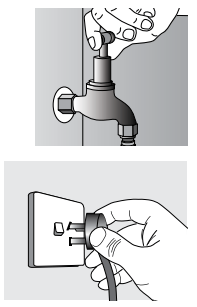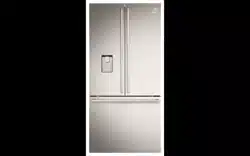Documents: Go to download!
User Manual
- User Manual - (English)
- Electrolux EHE5267SA 524L French Door Fridge Installation Guide - (English)
- Electrolux EHE5267SA 524L French Door Fridge Product Catalogue - (English)
- REFRIGERATOR FEATURES
- FREEZER FEATURES
- INSTALLING YOUR NEW APPLIANCE
- ICE AND WATER MODELS
- USING YOUR REFRIGERATOR
- CONTROLLING
- GENERAL INFORMATION
- TROUBLESHOOTING
Table of contents
Use Manual Refrigerator
REFRIGERATOR FEATURES
TOP MOUNT

Refrigerator/freezer control panel From this panel you can control the temperature of the refrigerator and freezer compartments as well as setting the Boost function or resetting the door alarm. For further information on how to use this feature refer to the section “About the User Interface”. |  |
Features may vary depending on model. Not all models will have features listed.
BOTTOM MOUNT

Refrigerator/freezer control panel From this panel you can control the temperature of the refrigerator and freezer compartments as well as setting the Boost function or resetting the door alarm. For further information on how to use this feature refer to the section “About the User Interface” | 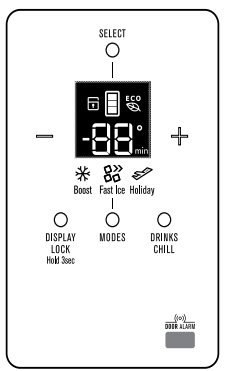 |
Features may vary depending on model. Not all models will have features listed.
ICE & WATER

Refrigerator/freezer control panel From this panel you can control the temperature of the refrigerator and freezer compartments as well as setting the Boost function controlling the Ice Maker or resetting the door alarm. For further information on how to use this feature refer to the section “About the User Interface”. | 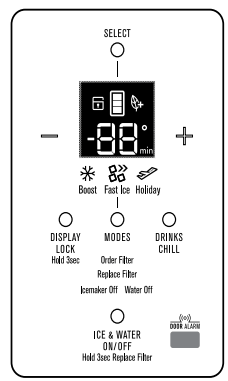 |
Features may vary depending on model. Not all models will have features listed.
FRENCH DOOR ICE & WATER

Refrigerator/freezer control panel From this panel you can control the temperature of the refrigerator and freezer compartments as well as setting the Boost function controlling the Ice Maker or resetting the door alarm. For further information on how to use this feature refer to the section “About the User Interface”. |  |
Features may vary depending on model. Not all models will have features listed.
SINGLE DOOR

Refrigerator control panel From this panel you can control the temperature of the refrigerator compartments as well as setting the Boost function or resetting the door alarm. For further information on how to use this feature refer to the section “About the User Interface”. |  |
Features may vary depending on model. Not all models will have features listed.
FREEZER FEATURES
SINGLE DOOR

Freezer control panel From this panel you can control the temperature of the freezer as well as setting the fast ice function or reset the door alarm. For further information on how to use this feature refer to the section “About the User Interface” |
|
Features may vary depending on model. Not all models will have features listed.
INSTALLING YOUR NEW APPLIANCE
UNPACKING
ENVIRONMENT ENVIRONMENTAL TIPS Most of the packing materials are recyclable. Please dispose of those materials through your local recycling depot or by placing them in appropriate collection containers.
Important – check for any damages or marks. If you find the refrigerator is damaged or marked, you must report it within 7 days should you wish to claim for damage/ marks under the manufacturers warranty. This does not affect your statutory rights. Clean your refrigerator thoroughly following the instructions in the “Cleaning” section and wipe off any dust that has accumulated during shipping.
LOCATING THE REFRIGERATOR
CAUTION Automatic aerosol systems (such as insect control) should not be located adjacent to the product as the spray may cause long term damage to the external surfaces of the appliance.
Do not put the refrigerator in a location that is too cold or is unprotected, for example in a garage or on a veranda. The ambient temperature should be above 10°C. Put the refrigerator in a dry place avoiding areas of high moisture or humidity. Ensure the refrigerator is located on an even surface.
Adequate ventilation around your refrigerator
The diagram below shows the recommended airspace to allow for ventilation of your refrigerator.

INSTALLING YOUR REFRIGERATOR
1. Roll the refrigerator into place.

The rollers are designed for forward or backward movement only. They are not castors. Moving the refrigerator sideways may damage your floor and the rollers. Before moving your refrigerator ensure height adjusting nut and the stability foot are fully wound up off the floor.
2. Wind the large height adjusting nut under door hinge down until the refrigerator is tilted back by 10mm (see diagram).
3. Wind the large height adjusting nut on the handle side down until the refrigerator is level and stable. If you have difficulty winding the nut or height adjusting foot down, have someone tilt the refrigerator back so you have better access.

4. Check the alignment of the refrigerator to the surrounding cupboards to see if it is level. You can adjust the level as detailed in step 2 and 3.

5. If you find your refrigerator rocks from corner to corner, it means your floor is uneven. Find a piece of plastic or hardboard etc. and pack it firmly under the roller.
6. You may now need to fine-tune the installation by repeating steps 3, 4 and 5.
7. When you have the appliance in its final position, it needs to be stabilised. Wind the stability foot under the door hinge down to the floor until it just makes contact with the floor. Lift the front of the appliance to take the weight off the stability foot, then turn it half a turn further to ensure firm contact with the floor. Wind the large height adjusting nut back up to ensure all the weight is now on the front stability foot.
8. Repeat step 7 for the stability foot on the handle side. Whenever you need to move the appliance, be sure to wind the feet back up so that the appliance can roll freely and be sure to reset it when reinstalling.

9. Plug your refrigerator straight into its own power point and never use a double adapter. If you need to roll the refrigerator to get to the plug, remember to raise the stability foot first.
10. Before you put any food in your refrigerator, it’s recommended you leave it on for 2 or 3 hours to check it is running properly.
FITTING THE HANDLES
For models with ‘Pole’ handles, the handles are supplied prepackaged with your refrigerator and will require fitting. Refer to the instructions provided in the pack. Congratulations! You have successfully installed your new refrigerator
ICE AND WATER MODELS
WARNING Connect to potable water supply only, if using tank or bore water in a model with an internal filter it is recommended to also use an external filter (not supplied). The new hose sets supplied with the appliances must be used and old hose sets should not be reused. Never connect the appliance to a hot water supply. WATER FILTER It should not be used on water that is micro biologically unsafe or with water of unknown quality. The service life of the filter may be reduced in water supplies that contain an excess of particles or other impurities. Reduced flow rate is an indication that a new filter is required. Failure to replace the filter when required can affect the function of the ice maker. Service calls caused by a failure to replace the filter are not covered by warranty. Replacement water filters are available from Electrolux Home Products Spare Parts Centres and can be posted to you for your convenience (refer to spare parts contact numbers on the warranty page).
Contents of installation kits

Water supply and plumbing
A drinkable water supply to suit a 1/2” tap fitting is required adjacent to the refrigerator. It is recommended that a licensed plumber install a new water supply outlet nearer to the appliance should the tubing supplied not be long enough. It is not recommended that the tubing be extended as this could adversely affect the flow of water to the ice maker or water dispenser. The water dispenser and automatic ice maker require a drinkable water supply with a pressure range of between 206kPa and 689kPa (30PSI and 100PSI). If the water supply is above 100psi a pressure limiting valve should be installed.
It is recommended that a noise reduction valve also be fitted in the water supply line. This will reduce water hammer and its effects from quick action household taps and fast acting valves on appliances. The refrigerator water valve is pre-fitted with a push-fit connector for inserting the water tube. When the tap connection is other than 1/2”, adapters can be purchased from plumbing supply stores or good hardware stores.
INSTALLATION
Please read before beginning installation. The water connection to your ice and water product can be self installed. However, it is recommended that you seek advice from a licensed plumber before commencing the installation.
IMPORTANT
Check for water leaks at all water connection points in the first 2 to 3 hours after installation, and correct it in case of any water leak. Recheck after 24 hours; if a leak still occurs, it is recommended to contact a licensed plumber for advice. Water is to be connected as per diagrams below.
Internal Filter

Step 1. Ensure that the refrigerator is disconnected from power supply. Step 2. Connect tap fitting to water supply tap. Tap must be close to the refrigerator Step 3. Push the tube into tap fitting past insertion mark. (NOTE: step 4 to step 10 relate to models with an external filter only). Step 4. Install brackets for filter close to tap. Plan to leave as much tubing as possible behind the refrigerator to enable it to be moved easily for cleaning or service. Do not screw the brackets into the refrigerator as this may void your warranty and permanently damage the refrigerator. Step 5. Write date on filter. The filter will need to be replaced every 6 months. Step 6. Extend the collar and clip a circlip around the collar at both ends of the filter. Step 7. Fit the filter to brackets with water flow arrow pointing up. |
|
Step 8. Push shorter tube into tap fitting past insertion mark. Step 9. Push other end into filter INLET. Step 10. Connect remaining tube length into filter OUTLET. Water filter contains carbon dust which is non-toxic. Using a large container, turn on water and purge the residual carbon dust from filter until water runs clear. Step 11. Connect other end of remaining tube length to inlet on bottom right hand side of refrigerator. Step 12. Turn on water and check all joints and tubes for leaks. Step 13. Reconnect the power. Step 14. Switch On Water Dispenser (except model EFE4227.) |
|
Using a large container, run the water dispenser to clear air from lines. This may take a few minutes. Purge and dispense a minimum of 2 litres of water. Initial water may be black in colour. This is residual carbon dust from the filter and is non-toxic. If the water is slow to shut off or the dispenser is dripping, air may still be in the lines. Either purge more water through the system to remove this air or allow some time for the air to be removed over subsequent dispensing. For normal use, water dispenser will automatically shut off after 2 minutes of continuous operation.
IMPORTANT
As the water cut off is not instant, leave the glass under the dispenser briefly until the water has stopped flowing to avoid spills. Clean and empty the dispenser drip tray regularly to avoid overflow. If you have not used the dispenser for some time, discard the first seven or eight cups of water (contaminants could have settled in the water pipes).
Step 15.
Switch ON Ice Maker. (except model ERE5047.) Refer to Controlling section
Once the refrigerator has been running for at least 24 hours remove the ice bin and dispose of the first few batches of ice to ensure that impurities have been flushed from the system.
Party Ice (except model EFE4227) When the Ice Bin is removed from the cabinet the Auto Ice Maker will continue to dispense ice into the top freezer drawer.
CAUTION Water dispenser should not be used for extended periods of time. After 2 minutes of continuous use the water dispenser will automatically shut off.
CHANGING THE WATER FILTER IMPORTANT
- Always fit the filter as per manufacturer’s instructions.
- If you need to replace water tube, only use approved water quality piping that meets the pressure requirements.
- Make sure your refrigerator is level to avoid uneven ice cubes.
- Replace filter at suggested intervals to avoid water/ice reduction and irregularities in taste.
- Remove and clean ice bin once a month, discarding unused ice cubes. This will ensure fresh, clean ice and smooth operation of your ice maker.
- Clean and empty the dispenser drip tray regularly to avoid overflow.
WARNING If you have not used the dispenser for some time, discard the first seven or eight cups of water and any ice that the ice maker produces in the first 24 hours (contaminants could have settled in the water pipes).
Internal Water filter
The water filter is located at the top left side of the fresh food compartment.
Replacing the water filter
You should change the water filter every six months to ensure the highest possible water quality.
If your refrigerator has not been used for a period of time (during a house move for example), change the filter before reinstalling the refrigerator. It is not necessary to turn the water supply off to change the filter. Be ready to wipe up any small amounts of water released during the filter replacement.
- Ensure that the ice maker is turned off (Diagram 1).
- Remove the filter by turning anti-clockwise 180˚.
- Slide the old water filter cartridge straight out of the housing and discard it. (Diagram 2).
- Unwrap the new filter cartridge and using the alignment guide, slide it gently into filter housing until it stops against the filter connection at the back of the housing. (Diagram 3).
- Engage the filter by firmly rotating clockwise until the filter snaps into position (once engaged the filter cannot be rotated further). (Diagram 4).
- Press a drinking glass against the water dispenser while checking for any leaks at the filter housing. Any spurts and sputters that occur as the system purges air out of the dispenser system are normal.
- After filling one glass of water, continue flushing the system for about four minutes.
- Turn on the ice maker. (Diagram 5).
- When the filter has been replaced press and hold the ‘Ice and Water’ button for three seconds to reset the filter replace timer.

USING YOUR REFRIGERATOR
Refrigerators work by transferring heat from the food inside to the outside air. This operation makes the back and sides of the refrigerator feel warm or even hot particularly at start-up and on warm days – this is normal.
Avoid placing food against the air vents in the refrigerator as it affects efficient circulation. If the door is opened frequently, a light frosting will occasionally occur on the freezer’s interior. This is normal and will clear after a few days. If the freezer door is accidentally kept open, a heavy frost will coat the inside walls and should be removed.
Your new refrigerator uses a high-speed compressor, along with other energy-efficient components, which may make unusual sounds and be more noticeable at night and quieter times. These sounds simply indicate your refrigerator is working how it should. They include:
- Compressor running noises;
- Air movement noise from the small fan motor;
- A gurgling sound, similar to water boiling;
- A popping noise, heard during automatic defrosting; and
- A clicking noise, prior to compressor start-up. Further details can be found in the Troubleshooting Guide.
IMPORTANT
For top mount refrigerators (where the freezer is on top of the fresh food compartment).
- Don’t place food forward of the ribs on the freezer floor, as it will keep the door open.
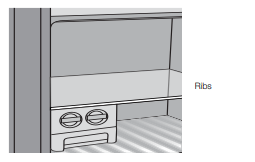
For bottom mount refrigerators (where freezer is below the fresh food compartment):
- Ensure all freezer drawers and shelves are pushed back completely to prevent them from keeping the door open

REMOVING FEATURES
FreshZone™ Double Insulated crisper
Removal
- Empty food from the crisper. On some models it will be necessary to remove the bottle storage bins.
- Pull the crisper drawer to the fully open position and lift off the extension slides.
- Remove the double insulated insert by lifting vertically out of the crisper drawer.
The double insulated insert and crisper drawer assembly should be cleaned using a soft cloth and mild detergent diluted in warm water.
Double Insulated Crisper Shelf - Removal, disassembly and cleaning (Bottom mount models)
- Remove the crisper drawer from the extension slides and take out of the refrigerator.
- Pull to remove the crisper shelf assembly from the refrigerator.
- Unclip the rear of the shelf glass by flexing the rear of the shelf frame.
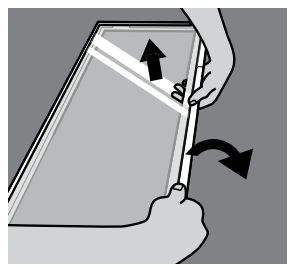
4. Slide the glass out of the shelf frame by pulling it towards the rear of the shelf frame

IMPORTANT Handle the glass carefully, taking care not to strike the edges of the glass.
5. Remove the double insulated insert.
6. Clean the frame assembly, glass and double insulated insert using a soft cloth and mild detergent in warm water. Dry using a soft cloth.

Remove the freezer shelf by lifting the catches on the right and left underside of the shelf to release the shelf then pull the shelf toward you.
Drawers fitted with telescopic slides
To remove the drawer for cleaning.
- Empty food from the drawer.
- Remove the drawer by pulling it forward and lifting the front to unhook it from the slides. Once you have removed the drawer, ensure the slides are pushed back so they are fully closed.
WARNING
Never close the door while the telescopic slides are extended. This may damage the slide and/ or refrigerator or cause the slide to become disengaged from the refrigerator.
To replace the drawer:
- Ensure the telescopic slides are pushed in all the way.
- Slide the drawer into place over the slides and push the bin in until it stops.
- Drop drawer into position.
Door bin mats
The door bin mats prevent items placed in the bins from sliding around, catch small spills in the door bins and allow small spills to be cleaned up by simply putting the mats in the dishwasher.
The mats are constructed from food-grade silicon and are dishwasher safe.

To remove the door bin mats, pull on the tab and lift vertically from the door bin. To refit, align the mat in the door bin and push down into place.
Freezer bottom bin
To remove the bin, pull the drawer out until it is open all the way then lift bin out from the front of the bin. When refitting insert the rear of the bin first then lower into position.
When replacing the bins after cleaning, we recommend fitting the lower bin first.

Twist and Serve Ice
Mounting the twist & serve dispenser to the other side of the freezer.
NOTE: this is only possible on Top mount models.

- Remove the ice bin and ice cube tray. If the ice tray assembly is frozen to the carriage, simply squeeze the tray and shelf together to break the ice.
- Before you remove the ice carriage, remember to disengage it from the glass shelf as it may result in damage to the assembly.
- Remove the centre runner by disengaging it at the front of the shelf, and removing it from the rear.

4. Refit the runner into the rear of the shelf on the right hand side and then engage the front.
5. Fit the carriage by sliding it into the runners until the front if the carriage engages with the shelf.
6. Refit the ice tray and ice bin.
WARNING
Fill the ice cube tray with potable water only.
CAUTION
LED lighting
Your appliance is fitted with long life LED lighting. In the unlikely event the LED lights should fail, then the LED lights should be serviced by the manufacturer.
Refer to the warranty page for contact details.
CONTROLLING
ABOUT THE USER INTERFACE
The following pages explain the various functions of the user interface to help you better understand how to get the most out of your new refrigerator.
IMPORTANT
NOTE: When you set a temperature, you set an average temperature for the whole refrigerator cabinet. Ensuring that you make only small adjustments and wait at least 24 hours to see if the new temperature is correct to your liking.
Checking the softness of ice cream is a good indication that your freezer is the right temperature, while checking the temperature of water kept in the refrigerator is a good way of checking the temperature of the food compartment.
Temperatures inside each compartment may vary, depending on how much food you store and where you place it.
High or low room temperature may also affect the actual temperature inside the refrigerator.
FUNCTIONS OF THE USER INTERFACE

IMPORTANT The factory default settings for the refrigerator is “3°C” and “-18°C” for the freezer. If you want to change the temperature, remember to make only small adjustments and wait 24 hours to see if it’s correct.


IMPORTANT
The factory default settings for the refrigerator is “3°C” and “-18°C” for the freezer. If you want to change the temperature, remember to make only small adjustments and wait 24 hours to see if it’s correct.
THE FREEZER USER INTERFACE
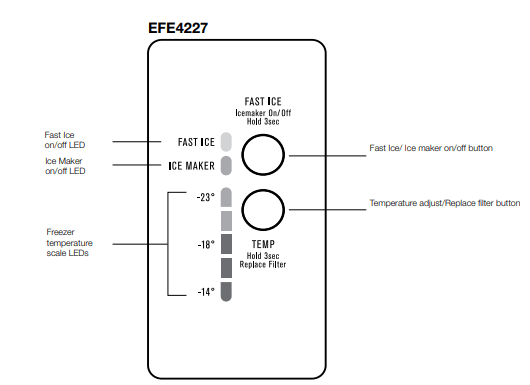

IMPORTANT
The factory default settings for the freezer is “-18°C”. If you want to change the temperature, remember to make only small adjustments and wait 24 hours to see if it’s correct.
ERROR CODES & ALARMS
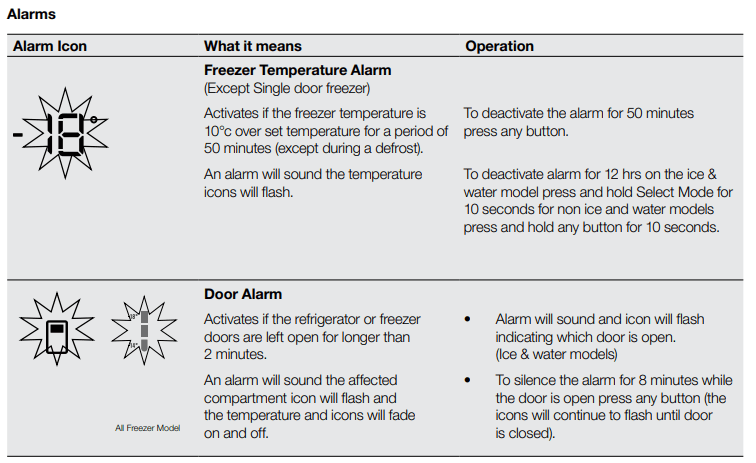
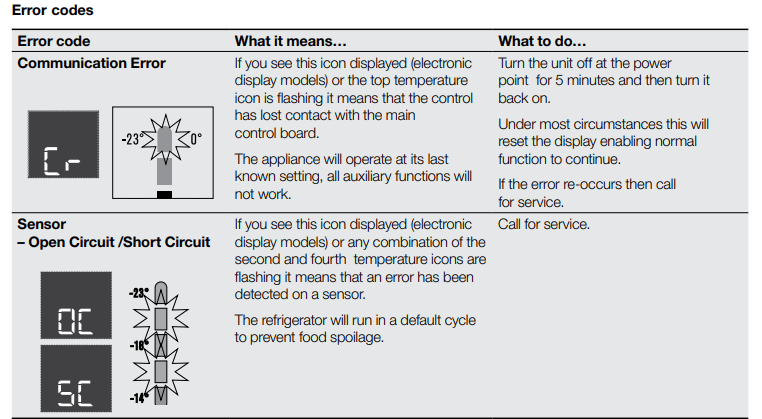
GENERAL INFORMATION
CLEANING YOUR REFRIGERATOR
WARNING
BEFORE CLEANING: Turn the refrigerator off at the power point and unplug the cord to prevent any chance of electrocuting yourself.
Your stainless steel refrigerator is manufactured from mark-resistant stainless steel. This stainless steel has a special advanced protective coating that eases the removal of marks such as fingerprints and water spots. To keep its appearance, clean it regularly with lukewarm soapy water and a soft cloth.
CAUTION
Never use stainless steel cleaners, abrasive pads or other cleaners that will scratch the surface. Damage to the appliance after delivery is not covered by your warranty.
Interior
Clean the inside of your refrigerator regularly with a soft cloth, unscented mild soap and lukewarm water. Thoroughly dry all surfaces and removable parts and avoid getting water on the controls. Replace removable parts, plug power cord in and switch the power on before returning the food.
Ice and Water
Clean the components of the ice maker /water dispenser regularly with a soft cloth, unscented mild soap and rinsing thoroughly with lukewarm water.
For further information on the care and cleaning of your Icemaker, Ice dispenser of water dispenser refer to the section "Ice and Water Models"
Door seals
Always keep door seals clean by washing them with a mild detergent and warm water, followed by a thorough drying. Sticky food and drink can cause seals to stick to the cabinet and tear when you open the door. Never use hot water, solvents, commercial kitchen cleaners, aerosol cleaners, metal polishes, caustic or abrasive cleaners, or scourers to clean your refrigerator.
Many commercially available cleaning products and detergents contain solvents that will damage your refrigerator. Use only a soft cloth with an unscented mild soap and lukewarm water.
CAUTION
To clean a crisper or freezer bin with telescopic extension slides, simply wipe with a damp cloth and warm soapy water.
Never immerse the cover in water, as this could affect the operation of the slide.
Switching off your refrigerator
If you switch off your refrigerator for an extended period, follow these steps to reduce the chances of mould:
- Remove all food.
- Remove the power plug from the power point.
- Thoroughly clean and dry the interior.
- Ensure that all the doors are wedged open slightly for air circulation.
FOOD STORAGE GUIDE

IMPORTANT
Please note, use this information as a guide only, actual storage times will vary depending on how you use your refrigerator, climatic conditions and the freshness of the food.
TROUBLESHOOTING
Appliance does not operate at desired temperature
In a modern frost free refrigerator / freezer, cold air is circulated around the various compartments through air vents using a high efficiency fan.
Refrigerator is too warm.
- Ensure food is allowed to cool before placing inside the refrigerator.
- Ensure the appliance is set up as per instructions on page 11.
- Ensure that contents are not obstructing the cooling vents.
- Ensure the door is not held open or is being opened too frequently.
Freezer is too warm.
- Adjust temperature to a colder setting.
- Ensure food is allowed to cool before placing inside the freezer.
- Ensure the appliance is set up as per instructions on page 11.
- Ensure that contents are not obstructing the cooling vents.
- Ensure the door is not held open or is being opened too frequently.
Food is freezing in the refrigerator.
- Adjust temperature to a warmer setting.
- Ensure that fruit and vegetables are stored in the crisper. Items with a high water content should not be placed near the cooling vents.
Unable to change temperature settings.
- Refer to function guide in Controlling Your Refrigerator.
- Ensure that user interface is in "awake" mode before trying to adjust temperature settings.
Appliance noise
Your new refrigerator may make sounds that your old one didn’t make. Because the sounds are new to you, you might be concerned about them. Most of the new sounds are normal. Hard surfaces, like the floor, walls and cabinets, can make the sounds seem louder than they actually are. The following describes the kinds of sounds and what may be making them.
Motor noise (compressor).
- Nothing. This is normal as your new refrigerator uses a variable speed compressor and fan that at start up and on warm days runs at a high speed to provide additional cooling.
- When less cooling is required the compressor and fan will run at a lower speed Note that the compressor noise may seem louder at the start of the on cycle.
A clicking noise heard just before the compressor starts.
- Nothing. This is normal as your new refrigerator has an automatic switching action of the temperature control, turning the compressor on and off.
Occasional gurgling, similar to water boiling.
- Nothing. As each refrigeration cycle ends, you may hear a gurgling sound due to the refrigerant flowing in your refrigerator system.
Airflow noise.
- Nothing, this is normal as your new refrigerator uses high efficiency fans to circulate air. Fan speed and noise may increase during periods of heavy usage or hot weather.
Rattling and other noises.
- Ensure that the cabinet is level and stable, refer to Installation Instructions on page 11.
- Check the surrounds of the appliance to ensure there is nothing touching or placed on top of the appliance.
- Ensure that contents of the appliance are not placed in such a way that they are vibrating (such as bottles).
Crisper Operation
Excess moisture build up in crisper. It is normal for there to be some moisture and humidity in the crisper bin.
- Ensure that the crisper is not over packed.
- Adjust crisper humidity slides.
Crisper bin can not be removed.
- If crisper bin interferes with the door bins, remove door bins before removing crisper.
- Position cabinet so that the door can be fully opened.
Freezing items in the crisper.
- Adjust temperature to a warmer setting
Appliance will not run It is normal for the freezer fan not to operate during the automatic defrost cycle, or for a short time after the appliance is switched on.
- Ensure that the cord is plugged into a live power outlet and outlet is switched on.
- Ensure that the household circuit breaker has not tripped or that the fuse has not blown.
- The appliance maybe in defrost mode, check again in half an hour.
Compressor motor seems to run too long
At normal room temperatures, expect your motor to run about 40% to 80% of the time. Under warmer conditions, expect it to run even more often. The variable speed compressor and fan that at start up and on warm days runs at a high speed to provide additional cooling. When less cooling is required the compressor and fan will run at a lower speed.
- Ensure that the doors are not held open.
- Check that large amounts of warm food have not just been placed inside the appliance.
- Note that the appliance will run more than normal just after you install it or when adjusting to temperature setting changes.
The exterior of the appliance is warm or hot to touch This is normal because the appliance transfers heat from the inside out through the outer panels and the divider between the doors.
- Ensure the appliance has the external clearances recommended in the section “Installing your new appliance”.
- The exterior of the cabinet will be much warmer on warmer days it may even feel hot to touch, as the appliance is working harder.
User interface will not respond To ensure settings are not accidentally changed the user interface will go into sleep mode when not in use. Press any button to wake user interface.
- Check that the user interface is in awake mode, refer to section “About the user interface”.
- Check that the user interface is not locked, refer to section “About the user interface”.
- If the user interface is frozen turn the appliance off for five minutes for the memory to clear, then turn back on.
- Check that the user interface is not in Sabbath Mode, refer to control instructions. (I&W models only).
Alarms sounding
- Check that all doors are fully closed.
- Ensure that the over temperature alarm is not being activated by hot food placed in the freezer.
- Check if the drinks timer has ended, refer control instructions.
- Check if the Filter Replacement alert is activated, refer control instructions. (I&W models only)
Frost build up
- Check that all doors are fully closed.
- Ensure that the doors are not opened too often.
- Ensure that the return air vents are not blocked with packaging.
- Ensure the seals are clean and not obstructed.
Odours
- The interior may need cleaning, refer to cleaning guide.
- Ensure that food is stored correctly as some food, containers and wrapping can produce odours.
- Check appliance for old or unusual food.
Lights not working The LED lighting is designed to dim automatically if the door is left opened for more than 5 minutes and turn off completely if the door is open for more than 7 minutes. Closing the door will reset the timer. The LED lighting is also designed to turn on gradually.
- Ensure that the cord is plugged into a live power outlet and outlet is switched on.
- Ensure that the household circuit breaker has not tripped or that the fuse has not blown.
- Check that the user interface is not in Sabbath Mode, refer to control instructions.
- Close and re-open the door. When door has been open for 5 minutes the lights fade to 50% then after 7 minutes they will turn off
Door operation
Freezer door pops open.
- This is normal and should re-close. This happens when the refrigerator door is closed too quickly.
- If the freezer door stays open, it indicates that the appliance needs to be tilted backwards a little further. Refer to section “Installing your new appliance”.
Self close not working.
- Check if your appliance has self closing hinges as not all models do.
- It indicates that the appliance needs to be tilted backwards a little further. Refer to section “Installing your new appliance”.
Door not sealing properly
- Ensure there is nothing that is preventing the door from closing such as appliance contents or items placed near the appliance.
- Ensure that the crisper/freezer bin is closed completely. Refit if required as referred to in the section "Using your refrigerator".
- Ensure the appliance is set up as per recommendations.
Door difficult to open and close
- If the door is difficult to open just after you have closed it this is due to the pressure equalising, the door will open normally after a few minutes.
Automatic Ice maker system
Ice maker does not produce ice or not enough ice The icemaker is designed to produce a tray of ice approximately every 3 hours, depending on room temperature and water temperature..
- Ensure that the cord is plugged into a live power outlet and outlet is switched on.
- Ensure that water is connected and turned on and there are no kinks in the water line.
- Ensure that the Ice Maker is switched on at the user interface refer to "About the User Interface" for details.
- Check that the water filter is not blocked or out of date.
- Check the water supply flow rate.
- If the freezer compartment is too warm, refer to "freezer is too warm" then wait 24 hours for the freezer to reach ideal temperature.
- Turn the unit off at the mains and leave for 2 minutes then turn the appliance back on (this will reset the icemaker unit). Check for ice production after 24 hours.
- Check that there is no obstruction under the ice maker and ensure the ice bin is fitted correctly.
Ice has bad odour or taste
- Cover food to ensure ice does not absorb foreign odours.
- Check that the water filter is not out of date.
- Interior of appliance or ice bin may require cleaning, refer to “Cleaning your refrigerator”.
- Discard stale ice monthly and allow ice maker to produce a fresh supply.
If you still require service
If you have a problem, and the problem persists after you have made the checks mentioned, contact your nearest Electrolux approved Service Centre or the dealer you bought the refrigerator from. Be ready to quote the model number, the 9-digit PNC and 8-digit serial number, which is stated on the label inside the refrigerator compartment.
See other models: EFE4227SA EVEP618SC PF91-6PR ETM4200SDRH EWF14013




